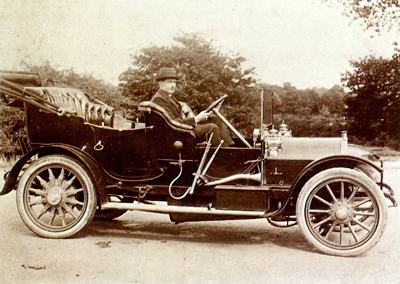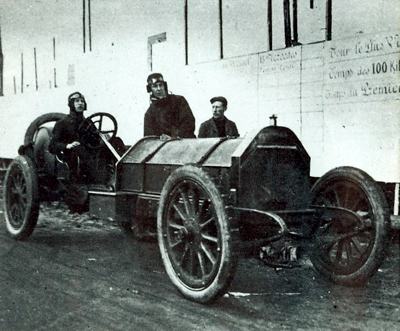|
Weigel
|
1906
- 1911 |
Country: |
 |
|
Danny Weigel
Danny Weigel was a colorful character who imported Continental cars into Britain in the early part of last century, and became one of the prime movers in the formation of the Clement Talbot Company in 1903. He was managing director of the concern until 1905, when he broke away to set up in business on his own. He was also an impassioned writer of letters to the motoring press, exceeded in bravado only by S. F. Edge of Napier.
First appearing in 1906, the 40 hp Weigel bore a suspicious resemblance to the contemporary 45 hp
Itala, right down to identical cylinder dimensions, though Weigel energetically asserted that the machine was entirely British-made.
The 1906 Olympia Show
The marque should have made its debut on Stand 93 at the 1906 Olympia Show, which was occupied by the Ivanhoe Motor Company, who were Weigel agents: but the Society of Motor Manufacturers & Traders refused permission on the grounds that Ivanhoe had only applied to exhibit Ivanhoe cars, and could not therefore exhibit Weigels.
The First Ever British Straight-Eight's
The second coming of the Weigel Motor Company to Olympia in 1907 was less eventful. Now exhibiting under their own name, Weigel (whose works were near the Angel, Islington) showed a three-speed 25 hp four-cylinder and the 40 hp, which had four speeds, and also offered a 60 hp six of identical cylinder dimensions to the 40 (and thus to the 60 hp Itala). But they did not mention their most spectacular achievement of the year, a concept as bold as it was unsuccessful: the building of the first-ever British straight-eight Grand Prix racing cars.
Laxen and Pryce Harrison
Two of these monsters were the sole British representatives in the 1907 French Grand Prix, driven by Laxen and Pryce Harrison. Formed by coupling two 40 hp engines in tandem, the Weigels had a swept volume of 14,866cc. There were two other makes of straight-eight in the race - the Dufaux-Marchand from Switzerland and the Porthcis from France. These had three and four speed gearboxes respectively, while the Weigel had only two. This may have been a contributory factor in the inordinate number of tire failures experienced by Laxen on the first lap, which held him back considerably: and neither car showed other than a disappointing performance, Laxen retiring on the fourth lap, Harrison on the sixth. The same combination of cars and drivers were unable to complete the distance in the Circuit des Ardennes.
 A Weigel tourer of 1908; it was fitted with a Barker Roi de Beiges coachbuilt body.
A Weigel tourer of 1908; it was fitted with a Barker Roi de Beiges coachbuilt body.
 A Weigel straight-eight pictured during the 1907 Circuit des Ardennes; the car's engine was of 14,866cc and was formed by coupling two four-cylinder 40 hp Weigel engines.
A Weigel straight-eight pictured during the 1907 Circuit des Ardennes; the car's engine was of 14,866cc and was formed by coupling two four-cylinder 40 hp Weigel engines. |
Wire Wheels With Detachable Rims
For the 1908 Grand Prix Weigel constructed a team of three more conventional four-cylinder cars, with three speeds and a swept volume of 12,781cc; drivers were Harrison, Laxen and Shannon, and the cars featured the odd combination of wire wheels with detachable rims, while wickerwork shields protected their fuel tanks against flying stones.
Shannon's steering packed up on the second lap, while Laxen wrote his car off by ramming a sandbank in the village of Eu. On the sixth lap, Harrison emulated his team-mate, rolling his car in the same village. Thus ended the sporting career of the Weigel.
Crowdy Cars Limited
Financial difficulties emerged in 1907, as the company was reformed, and moved to a new factory in Olaf Street, Latimer Road, Notting Hill, where they continued to manufacture the 25 hp and 40 hp fours and the 60 hp six. A new 20 hp, which did not correspond with any existing Itala, was announced for 1910, but that year Weigel Motors ceased production.
The Seeker After Rational Practical Progress
The firm's assets were acquired by Crowdy Limited, who continued manufacture of cars in the Olaf Street works, at first merely continuing the existing 25 hp and 40 hp Weigel designs: then they blossomed forth with two new models aimed at 'the seeker after rational practical progress' and fitted with Hewitt piston valve engines and worm final drive.
Dashboard radiators identical to Renault were fitted to these models, a 19 hp four and a 29 hp six. Three years guarantee was offered on the Crowdy cars; but at the end of 1911 they moved to West Heath Works, Northfield, Birmingham (the cars having acquired normally-located radiators in the interim) and proceeded to go out of business.
